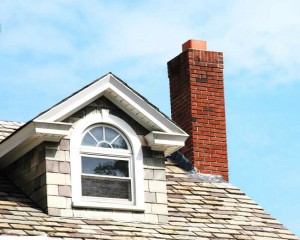Can you identify the major components of your masonry chimney? If you cannot, you are not alone. Many homeowners have very little knowledge about their fireplace and chimney systems. When you do not know the names of certain parts or what exactly each part is supposed to do, it can be difficult to describe a chimney problem you could be experiencing. Knowing the details of each component of the anatomy of your chimney can help you discuss your issue with chimney professionals, like our staff at Weststar Chimney Sweeps. As part of our responsibilities as Chimney Safety Institute of America (CSIA)-certified chimney sweeps, educating our customers about the major parts of their fireplace and chimney systems is one of our top priorities. We would like to explain each component of the anatomy of a masonry chimney to help you be able to identify these parts and their specific functions.
As identified by the CSIA, the anatomy of a masonry fireplace and chimney system consists of the following parts:
- Mortar Crown – Also commonly known as a chimney crown, this component is located on top of the chimney to prevent water penetration of the bricks and mortar as well as to stop water leaking down the flue and into your home.
- Flue – Found in different shapes and sizes, the flue is the chamber that vents out the corrosive byproducts of combustion from the fireplace. A single chimney can have multiple flues if several fireplaces or stoves are connected to the same chimney. Your flue should always be clear from blockages to allow proper airflow.
- Smoke Chamber – Located above the firebox and below the flue, the smoke chamber allows smoke to mix and rise up the flue. Commonly constructed from terracotta tiles, this part is also known as the chimney throat.
- Smoke Shelf – Functioning with the smoke chamber to push smoke out the flue, the smoke shelf can be found behind the damper and is at the bottom of the chimney.
- Damper – Typically located in the same area as the smoke chamber and smoke shelf, the damper seals your chimney closed when the fireplace is not in use. A very important part of the efficiency of your chimney, the damper needs to function properly to keep heated air from escaping out the chimney when there is no fire.
- Lintel – The heavy piece of angle iron that holds up the bricks over the center of the fireplace, the lintel can be found embedded into the brick.
- Firebox – A crucial part of your fireplace and chimney system, the firebox is a two- or three-walled structure that contains the direct heat of the fire and guides the smoke into the smoke chamber. As the firebox is exposed to such high temperatures, this component tends to deteriorate faster than other parts of the anatomy of your chimney. It is crucial that the firebox is constructed with the right materials and kept in good repair.
- Ash Dump – Located right below the center of the firebox, the ash dump is equipped with a door. When the ash dump door is open, ashes from the fire fall into the ash dump. This component allows for simple ash removal from the firebox.
If you have any questions about any of these parts, get in touch with Weststar Chimney Sweeps. We are happy to tell you more about the anatomy of your masonry chimney.

